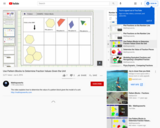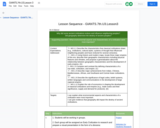
This lesson uses a cartoon video to teach the concept of responsible citizenship.
- Subject:
- Social Science
- Material Type:
- Lecture Notes
- Date Added:
- 04/05/2021

This lesson uses a cartoon video to teach the concept of responsible citizenship.

This powerpoint contains 9 pictures of rural, suburban, and urban communities. The slides are blank (they do not say which community type they are) which allows for discussion.

Test prep/review sheets for students for the following topics: Cells; Reproduction; Separating mixtures; Rocks; Light and Sound; Electricity

Explore your own straight-line motion using a motion sensor to generate distance versus time graphs of your own motion. Learn how changes in speed and direction affect the graph, and gain an understanding of how motion can be represented on a graph.

Measurement video reviewing measurement and subtraction

This web-based graphing activity explores the similarities and differences between Velocity vs. Time and Position vs. Time graphs. It interactively accepts user inputs in creating "prediction graphs", then provides real-time animations of the process being analyzed. Learners will annotate graphs to explain changes in motion, respond to question sets, and analyze why the two types of graphs appear as they do. It is appropriate for secondary physical science courses, and may also be used for remediation in preparatory high school physics courses. This item is part of the Concord Consortium, a nonprofit research and development organization dedicated to transforming education through technology. Users must register to access full functionality of all the tools available with SmartGraphs.

This PowerPoint was created to go hand in hand with Florida Studies Weekly series. It goes with week 1 for first grade. It is about American symbols, Labor Day, and comparing our American Flag with the first American Flag. Common Core and Standards based.

This is a fun way to review the features of a map! Enjoy! To see more social studies activities, click on the links below: Social Studies Interactive Notebook Ancient Egypt Interactive Notebook Activities 5 Major Religions Interactive Notebook Activities*Please rate me :) *Remember to "follow" m...

Free social studies word wall! Ten cards covering geography and geology topics, PLUS colorable interactive notebook inserts.

Free online mobile-friendly Trigonometry end-page notes and formulas.

The video explains how to determine the value of a pattern block given the model of a unit.http://mathispower4u.com

Investigate the effect of gravity on objects of various mass during free fall. Predict what the position-time and velocity-time graphs will look like. Compare graphs for light and heavy objects. Was Galileo Right is the last of five SmartGraphs activities designed for a typical physical science unit of study on the motion of objects.

Questions about weather and climate; on thought bubbles; to be used for display.

5 – U2.3.1 Locate the New England, Middle, and Southern colonies on a map.
5 – U2.3.4 Describe the development of the emerging labor
force in the colonies

7– W3.1.1 Describe the characteristics that classical civilizations share (e.g., institutions, cultural styles, systems of thought that influenced neighboring peoples and have endured for several centuries).
7 – W3.1.2 Using historic and modern maps, locate three major empires of this era, describe their geographic characteristics including physical features and climates, and propose a generalization about the relationship between geographic characteristics and the development of early empires. (G)
7– W3.1.3 Compare and contrast the defining characteristics of a city-state, civilization, and empire. (C)
7 – W3.1.5 Describe major achievements from Indian, Chinese, Mediterranean, African, and Southwest and Central Asian civilizations. (G)
7 – W3.1.9 Describe the significance of legal codes, belief systems, written languages and communications in the development of large regional empires.
7 – W3.1.11 Explain the role of economics in shaping the development of classical civilizations and empires (e.g., trade routes and their significance, supply and demand for products). (E)

The Unfinished Business of Women’s Equality: Educators’ Guide and student handouts is very extensive and provides a great many additional resources. This is a very powerful and necessary topic that all individuals need to discuss, share ideas and expand their understanding of the information. I have included a video on the 14th Amendment interview that HS students had with Justice Ruth Bader Ginsburg.